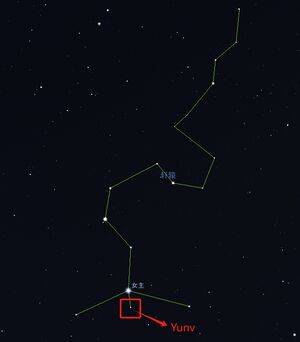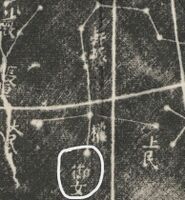Yunü: Difference between revisions
Boshunyang (talk | contribs) No edit summary |
|
(No difference)
| |
Revision as of 08:17, 15 July 2024
Yunü御女 is the star in the middle of the southernmost stars of the Xuanyuan轩辕 constellation.
Etymology & History of the term
According to ancient Chinese astrological theory, the Xuanyuan constellation represents the group of imperial consorts. In this context, 31 Leo was given different meanings by various astrological schools. The Huangdi school, for instance, believed this star represented the son born to the empress (alf Leo), while other scholars such as Shi School and Jiao Yanshou identified it as Nüyu[1], indicating a lower-ranking concubine of the emperor. The latter meaning became popular later. Before the Tang dynasty, this star was consistently referred to as Nüyu. However, after the Song dynasty, the term Yunv became more prevalent.
The two terms "Nüyu" and "Yunü" have the same meaning, with the order of the two syllables being reversed.
Images
- Yunü
IAU WGSN - Star Name Discussion
In 2024 the name was suggested to the WGSN. For the use in English language (research papers in astrophysics), we prefer the variant "Yunü" for 31 Leo (SIMBAD). This star is a high proper motion-star with a visual magnitude of 4.38 mag. The spectral class K3 describes its reddish/ orange colour. 31 Leo currently lacks a proper name in SIMBAD.
Some editor in Wikipedia transliterated it as "Yùnǚ" - but I can't find the source, however Google translate transliterates it as "Yù nǚ".
Alternative Mentionings and Spellings
We found other references that mention the name and provide a transliteration that should be referenced in the online page.
- 1) "Astrology and Cosmology in Early China: Conforming Earth to Heaven" by David W. Pankenier (2013).
- 2) "A Non-Ptolemaic Islamic Star Table in Chinese" by Benno van Dalen in Sic itur ad astra. Studien zur Geschichte der Mathematik und Naturwissenschaften. Festschrift für Paul Kunitzsch zum 70. Geburtstag (eds. Menso Folkerts and Richard P. Lorch), Wiesbaden (Harrassowitz) 2000, pp. 147-176.
From Pankenier:
- Footnote 71: "The small star to its south, 31 Leo with apparent magnitude 4.37, is Lady-in-Waiting, nü- yü 女御 (or 御女)."
- Footnote 95: "I.e. the Official Consort or Empress, consistently identified as “large” or the “largest,” is Regulus. The small star to its south, 31 Leo with apparent magnitude 4.37, is Lady-in-Waiting, nu ̈yu, 女御 (or yunu ̈御女)."
From van Dalen (see attached scan of page from his book):
- "Waiting-maid 御女 yunü 31 Leo"
We can't find the transliteration "Yunv" anywhere online or in printed books, and if this page on the pinyin "ü" is any guide then it does NOT appear to be pronounced as a fricative "v", but more like the "u" in "yuan".
References
- general list of References
- general list of Chinese References
- ↑ Qutan Xida. Kaiyuanzhanjing 开元占经. Beijing: Jiuzhou Press, 2012:643-644.







